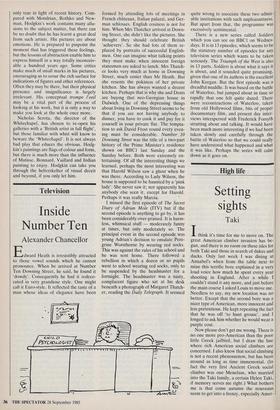Exhibitions
Howard Hodgkin: Fifty Paintings 1973-85 (Whitechapel Gallery till 3 November)
Talking about art
Alistair Hicks
6 Talking About Art' is a satirical work included in Howard Hodgkin: Fifty Paint- ings at the recently re-opened Whitechapel. Mr Hodgkin does not altogether approve of art talk as this painting reveals. It is highly regimented, consisting of well-ordered geometric formations, tightly contained in a heavy purple-painted framework. The planes of colour act as a dictionary of brushstrokes, each box enclosing a different technique. The flat surface is broken by the deceptive use of the raw canvas and a glimpse of a fluent and bold stroke, yet this only high- lights the two-dimensionality of the con- versation. It is not going anywhere.
Hodgkin does not only attack verbal pretension. He admits that it is difficult to write about his work. 'John Russell has been planning a book on my work for some nine years. He doesn't know what to say about Bonnard or me!' This is high praise indeed as it is obviously hardest to describe adequately the most successful expressions in other mediums. Having established my own profession's redundance, I would like to act the maverick and question Hodg- kin's apparent simplicity. Once he has painted the pictures and given them surpri- singly precise titles, he is reluctant to tell us more, although the work invariably refers to a specific occasion. 'It often creates a barrier between the viewer and the pic- ture,' he says. Yet he is forever creating barriers himself. He is the master of the visual obstacle race. This is most clearly demonstrated in two recent tondos.
`Bust' and 'Dark Moon' are both un- fashionably small. Most sane people would dismiss the latter at first sight and walk on. It seems little more than squirls of mawkish greys. It's all very well to stare dreamily at the cloud-covered moon, but it is hardly a painterly subject. Then the eye is caught. The warm red rim seizes the attention and the silvery magic of the moon's vestments is brought into focus. Hodgkin treats view- ers with confident disdain. He can make their eye do what he likes. 'Bust' is bolind by a strong circle of yellow and it pulls its victims in with the power of a whirlpool. It winds us up until the tension snaps and we are left wondering what happened to us. there is no escape.
Hodgkin plays cat and mouse with us. He creates barriers, so that he can break them down and present new art. Ostens- ibly his visual language antagonises every- one. He tempts the British public with his bright colours and the connection with India, but loses them in the freedom of his form. The more mature gallery-goer, nur- tured in the full glare of Minimalism and classical abstraction, is insulted by the dangerous diversity of size and the tight, enclosing painted frameworks that are locked onto the otherwise free composi- tions. Trompe l'oeil sits as naturally in his armoury as those of baroque or rococo painters, yet he turns this weapon savagely upon itself. It is used to emphasise the flat surface. Similarly he chooses the piece of wood on which he is working with the care of a mediaeval artisan. Texture, shape and size are selected and rarely repeated. He is not a series painter. Each work is an individual object and here we arrive at the crux of the matter. Hodgkin does not present us with paintings designed and only suited for the great public wallspace; by their highly individual manufacture they appear as objects that one wants to touch, to hold in one's hands. They shine like jewels and possess the intimacy of an objet d'art. They cut through preconceptions on painting.
`Jealousy' may be a two-dimensional affair, with the pit of the stomach being eaten by a green-spotted, yellow hole, but it is projected forward into the room by its violent green sides. Several artists have painted frames in an effort to get closer to their viewers, but most have only ever achieved a superficial success. Hodgkin's efforts have worked, because he gives us a single work of art. There is never any question of dividing the canvas from the frame. The artist has fought hard for it, but his vision is remarkably consistent. It has united many elements. Critics, and Hodg- kin himself, have been adamant that he is representational and not abstract. This is only true in light of recent history. Com- pared with Mondrian, Rothko and New- man, Hodgkin's work contains many allu- sions to the subject matter, but there can be no doubt that he has learnt a great deal from such artists. His pictures are about emotions. He is prepared to pinpoint the moment that has triggered these feelings, but the lessons of abstraction enable him to express himself in a way totally inconceiv- able a hundred years ago. Some critics make much of small marks in his pictures, encouraging us to scour the rich surface for indications of figures and other references. Often they may be there, but their physical presence and insignificance is largely irrelevant. His conceptual trompe toed may be a vital part of the process of looking at his work, but it is only a way to make you look at the whole once more.
Nicholas Serota, the director of the Whitechapel, has chosen to re-open his galleries with a 'British artist in full flight', but those familiar with whist will know to beware the `Whitechapel'. It is not always bad play that educes the obvious. Hodg- kin's paintings are flags of colour and form, but there is much more than the influence of Matisse, Bonnard, Vuillard and Indian painting to enjoy. Hodgkin can take you through the helterskelter of visual deceit and beyond, if you only let him.















































 Previous page
Previous page